Samsung SSD XP941 Review: The PCIe Era Is Here
by Kristian Vättö on May 15, 2014 12:00 PM ESTMac Benchmarks: QuickBench, AJA & Photoshop Installation
Since the XP941 is currently only bootable in Macs, I decided to run some benchmarks with the XP941 inside a Mac Pro. The specs of the Mac Pro are as follows:
| Test Setup | |
| Model | Mac Pro 4.1 (Early 2009) |
| Processor | Intel Xeon W3520 (2.66/2.93GHz, 4/8, 8MB L3) |
| Graphics | NVIDIA GeForce GT120 512MB GDDR3 |
| RAM | 12GB (2x4GB + 2x2GB) DDR3-1066 ECC |
| OS | OS X 10.9.2 |
We would like to thank RamCity for providing us with the Mac Pro, so we were able to run these tests and confirm boot support.
I installed OS X 10.9.2 to all drives and they were the boot drives when benchmarked, just like they would be for most end users. As I mentioned on page one, RamCity actually sent us two 512GB XP941 and I just had to put them in RAID 0 configuration. With a Mac you can easily boot from a software RAID 0 array, so all I had to do was to create a RAID 0 array in Disk Utility and select it as the boot volume. I placed the drives in PCIe slots 2 and 4 to ensure that both drives were getting full PCIe bandwidth and we wouldn't run into bottlenecks there. I picked Intel's 480GB SSD 730 to be the comparison point as it was lying on my table and is among the fastest SATA 6Gbps SSDs in the market. Note that the 2009 Mac Pro only supports SATA 3Gbps, so there's obviously some performance penalty from that as the benchmarks show.
QuickBench
QuickBench is one of the more sophisticated drive benchmark tools for OS X. It's shareware and retails for $15 but compared to the freeware tools available, it's worth it. While QuickBench lacks the option to increase queue depth, it supports various transfer sizes from 4KB to up to 100MB (or more through a custom test). For this test, I just ran the standard test where the IO sizes range from 4KB to xMB. Additionally I ran the extended test, which focuses on very large IOs (20-100MB) in order to get the maximum performance out of the drives. In both cases the tests ran for 10 cycles to ensure sustained results.
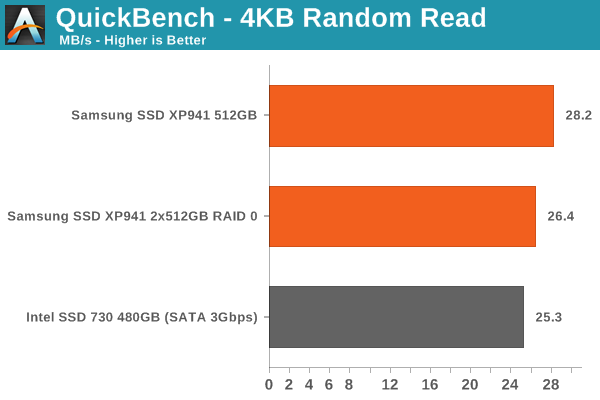
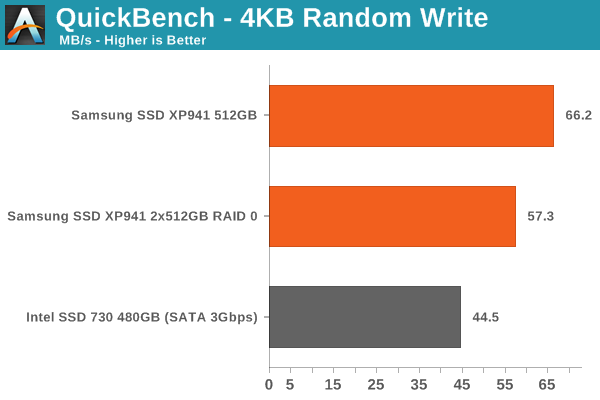
The random results don't reveal anything interesting. The RAID 0 array is slightly slower due to the overhead from the software RAID configuration but overall the results make sense when compared with our Iometer scores. Bear in mind that QuickBench only uses queue depth of 1, whereas our Iometer tests are run at queue depth of 3, hence there's a difference that is roughly proportional to the queue depth.
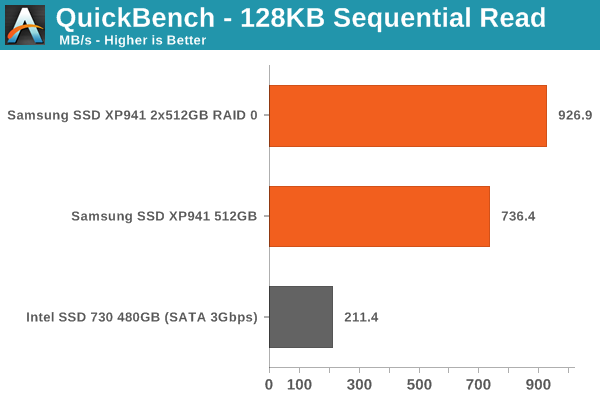
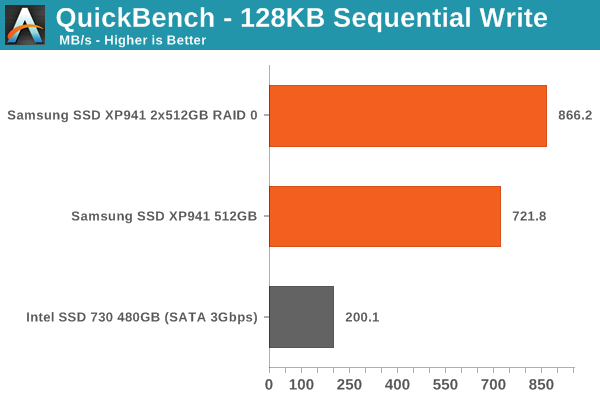
The sequential tests show that the XP941 seems to be slightly slower in the Mac Pro compared to sequential performance in Iometer. In this case both tests are at a queue depth of 1 and should thus be comparable, but it's certainly possible that there are some other differences that cause the slightly slower performance. Either way, we are still looking at much, much higher performance than any drive would provide under the Mac Pro's native SATA 3Gbps interface.
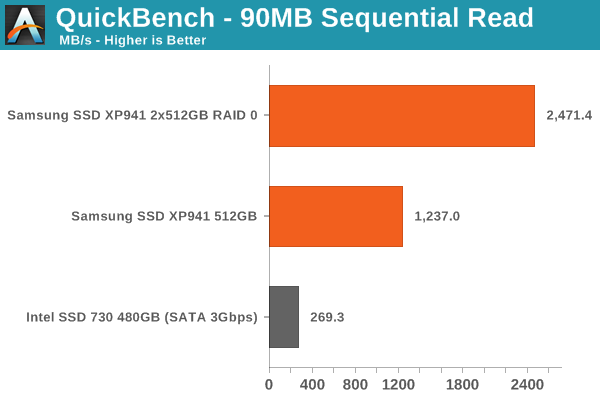
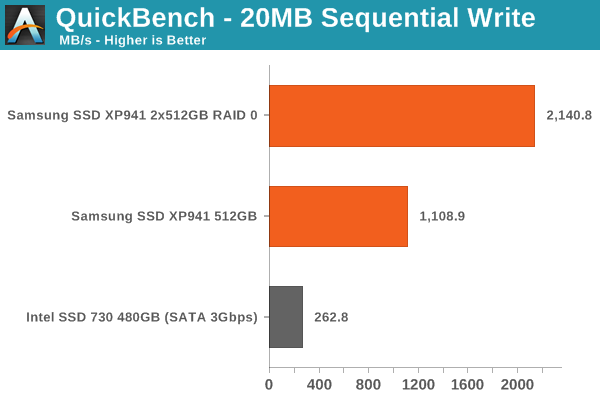
Since QuickBench doesn't allow increasing the queue depth, the only way to increase performance is to scale the transfer size. QuickBench's preset tests allow for up to 100MB IO sizes and I ran the preset that tests from 20MB to 100MB and picked the highest perfoming IO sizes that were 90MB and 20MB in this case. There wasn't all that much variation but these seemed to be the highest performing IO sizes for all three configurations.
Now the XP941 and especially RAID 0 show their teeth. With two XP941s in RAID 0, I was able to reach throughput of nearly 2.5GB/s (!) and half of that with a single drive. Compared to the SSD 730 in the SATA 3Gbps bus, you are getting over four times the performance and to reach the performance of X941 RAID 0 you would need at least ten SSDs in a SATA 3Gbps RAID 0 configuration.
AJA System Test
In addition to QuickBench, I decided to run AJA System Test as it's a freeware tool and quite widely used to test disk performance. It's mainly designed to test the performance of video throughput but as the results are reported in megabytes per second, it works for general IO testing as well. I set the settings to the maximum (4096x2160 10-bit RGB, 16GB file size) to product the results below.
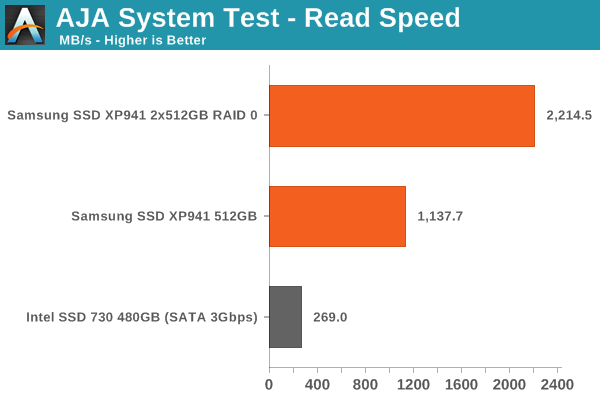
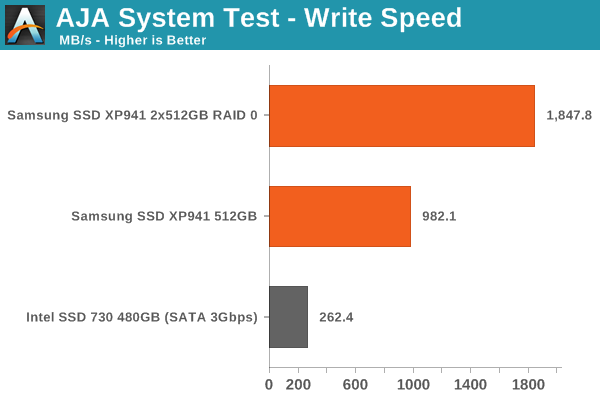
The results are fairly similar to the QuickBench ones but the performance seems to be slightly lower. Then again, this is likely due to the difference in the data the software uses for testing but the speeds are still well over 1GB/s for a single drive and 2GB/s for RAID 0.
Adobe Photoshop CS6 Installation
One of the most common criticism I hear towards our tests is that we don't run any real world tests. I've been playing around with real-time testing a lot lately in order to build a suite of benchmarks that meet our criteria but for this review I decided to run a quick installation benchmark to see what kind of differences can be expected in real world. I grabbed the latest version of Photoshop CS6 trial from Adobe's website and installed it to all three drives while measuring the time with a stopwatch.
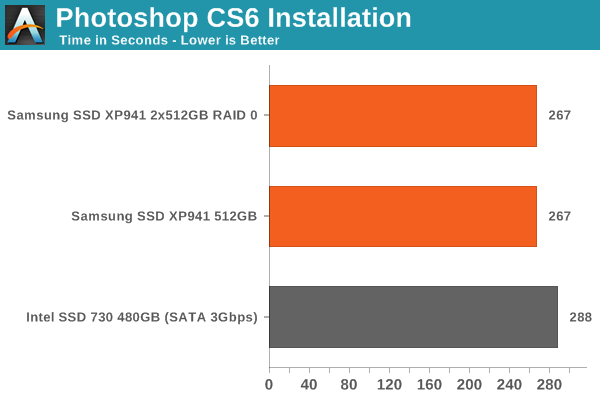
Obviously the gains are much smaller in typical real world applications. That's because other bottlenecks come to play, which are absent when only testing IO performance. Still, especially for IO heavy workloads the extra performance is always appreciated even if the gains aren't as substantial as benchmarks show.










110 Comments
View All Comments
hulu - Thursday, May 15, 2014 - link
Second page of review, fourth paragraph, states they were only able to aquire the 512 GB version, since as an OEM product Samsung isn't sampling the drive to media.Always helps if you read the entire story before commenting!
JoyTech - Friday, May 16, 2014 - link
In that case, the reviewer better leave out the 128 & 256 GB out or mention the exclusions on first page, not 2nd page, 4th para; a good reviewer should make it easy for readers to access info, not act as lawyers and read the fine print!Also, I forgot to mention that their SSD bench marks have same problem (http://anandtech.com/bench/SSD/730), where they leave out Samsung SSD 840 EVO 250 GB, which is perhaps the best selling SSD in the market now. Very few people give a crap about 1 TB products, which is so proudly displayed in the bench!
Kristian Vättö - Saturday, May 17, 2014 - link
The first page is just an introduction with no mention of the XP941 anyway. It wouldn't have fit the context there and in the end I at least like to think that the reader reads the whole review and not just a paragraph or two. It's rather hard to write something for a reader who reads a part here and part there.As for the 250GB 840 EVO, it is in the bench but we haven't run Storage Bench 2013 on it. That's because the test itself takes around 24 hours to complete and with the strict review times we don't usually have the time to test all available capacities.
critical_ - Thursday, May 15, 2014 - link
Paradoxically, my problem with the M.2 form-factor is the number of sizes available to manufacturers. My Dell Venue 11 Pro tablet has a 2260 size 256GB SSD by Lite-On. There have been lots of firmware issues. The best thing would be to swap it out with a Samsung or Intel variant. However, there isn't much selection out there and 2260 is an oddball size. I'd like a 1TB mSATA SSD but it doesn't exist.Lenovo was smarter in this regard. Their Yoga 2 Pro uses the newer connector for the wireless card but the SSD is plain old mSATA. This allows me to pick from a variety of options without size concerns.
I know I'm ranting and it is still early in the M.2 game but I hope manufacturers settle on providing high capcities in the 2242 and 2260 sizes with plates (like half mPCI-E to full mPCI-E) to allow them to fit in bigger slots.
Babar Javied - Thursday, May 15, 2014 - link
Getting a smaller drive to fit into the bigger slot is easy. As you said, this can/should be easy with the use of "plates" or "expansion cards". So give it some time and you should have lots of options for your device. Should the 2260 size still remain an oddball, you can always get a 2242 size with extensions to help it fit into the bigger slotsdstarr3 - Thursday, May 15, 2014 - link
All due respect to the awesome performance the new interface promises, I still feel like it's going to be a while before the 6Gbps bottleneck makes my computer feel frustratingly slow.darwinosx - Thursday, May 15, 2014 - link
Read the benchmarks or ask someone who has been using PCIE SSD on a Mac for some time now. It's much faster and noticeable.Calista - Friday, May 16, 2014 - link
But also highly depending on what you're doing. Maybe most people are accepting a slight drop in performance in exchange for less issues with compatibility and the option of moving the drive to a second machine down the line or mounting it in a usb cabinet.Sabresiberian - Thursday, May 15, 2014 - link
I have 2 issues with PCIe as a storage interface, at this point in time.First is that, for me, as a high-end gaming PC user, the number of PCIe lanes to the CPU is already limited. SATA lanes are not since I simply don't use that many storage devices. The second is cost. A few weeks ago I bought 2 480GB Sandisk Extreme II's for $300 each, and just saw them for $260 each listed on Newegg - so, for less than the cost of a 512GB XP941 I can get around twice the storage at similar speeds if I install using RAID 0 using current high-end SSD devices.
Until Intel and/or AMD decides to provide more direct PCIe lanes and the cost comes down, PCIe SSDs are just an interesting upcoming technology, for me. :)
SirKnobsworth - Thursday, May 15, 2014 - link
At least on an Intel platform, you wouldn't normally be using lanes from the CPU for a storage device (which are usually dedicated to graphics) - you'd be using lanes from the chipset (of which there are usually 8).